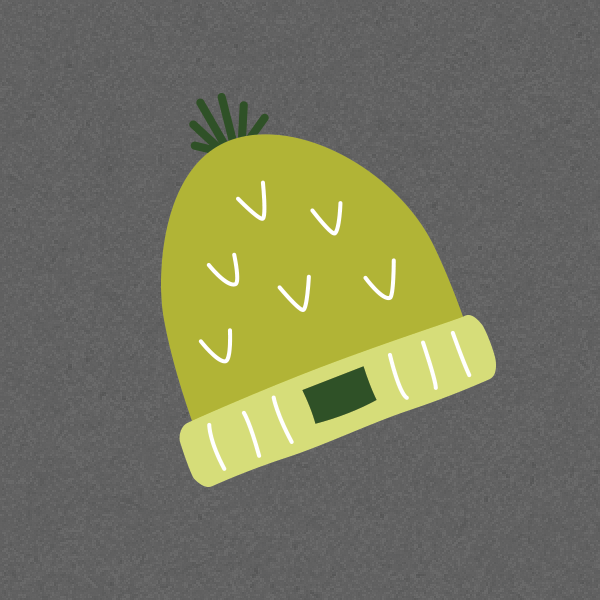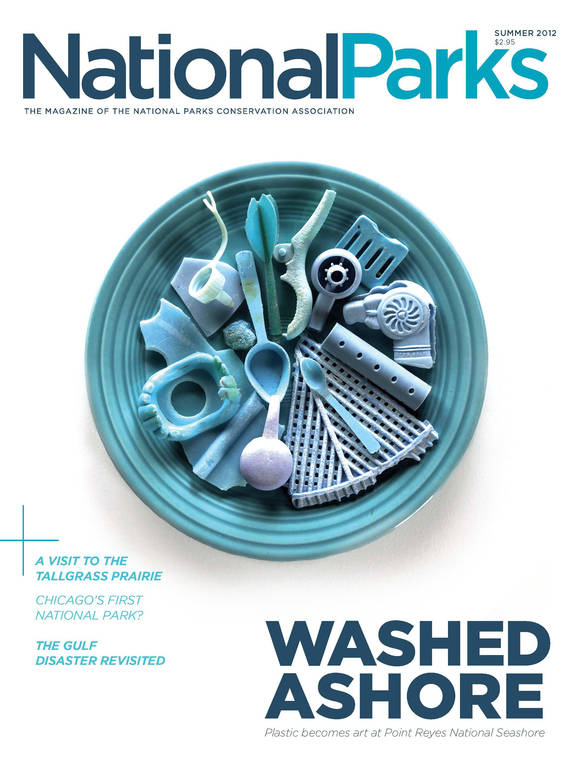Summer 2012
Found Objects
Two artists turn trash into treasures at Point Reyes National Seashore.
It’s spring of 1996 in Point Reyes National Seashore, California. Richard Lang and his 14-year-old son, Eli, are removing invasive plants for a volunteer project when they take a lunch break at Kehoe Beach—a spot they love for its spectacular wildflowers. But that day, something else dominates the landscape: plastic. A lot of plastic. In all shapes, sizes, and colors: weathered shards, bottles and caps, ropes and netting, even car bumpers. Washing in with the tide and trashing the beach. Richard and Eli are disgusted and can’t shake the image from their minds.
They returned the following week on a mission and ended up hauling out seven huge garbage bags full of trash. “We were going to throw them away at the dump, but then it occurred to us that ‘away’ was some mythical land that doesn’t exist,” Richard says. Instead, they started sorting through the plastic and separating items by color. And that’s when the problem began to shift: This wasn’t trash—it was art material. And that was a handy thing, as Richard happened to be a professional sculptor.
The very same spring, an artist named Judith Selby was picnicking regularly at a park on Richardson’s Bay near San Francisco. While she was eating, she’d notice brightly colored bits of plastic along the shore. “I’m always looking for art materials, especially free art materials, so I started gathering them and making small sculptural pieces,” she says.
But Judith and Richard wouldn’t meet for three more years, when she walked into Richard’s fine-art printing store in San Francisco to get an estimate for a project she was working on. They were drawn to each other immediately, and it took just one date—which included a stroll along Point Reyes’ seashore—to make the art connection.
“We were walking on the beach, and Judith picked up a piece of plastic, and I asked, ‘Are you going to keep that?’” Richard says.
“And I said, ‘Wait a second, you just picked up a piece of plastic too—are you going to keep that?’” Judith adds. “What are the chances of finding somebody else who likes to pick up plastic and make artwork out it? It was just too extraordinary.”
They began collaborating on art projects right away, and four years later, they got married. In 2001 the park’s main visitor center and another local gallery housed their first exhibit: “One Beach, One Year,” a year’s worth of plastic found on Point Reyes’ Kehoe Beach. The couple did more than simply hang colorful images on walls; they led the public on guided trips to the beach to gather even more plastic, then provided a “creation station” outside the exhibit where people could make something of their shoreline debris. It was the beginning of a beautiful trend. Long after the exhibit came down (and their artwork moved on to places as esteemed as San Francisco Museum of Modern Art’s Café Museo and Artist’s Gallery Windows), Judith and Richard continued to run into beachgoers collecting plastic in Point Reyes.
“It really had a direct impact on people,” says Loretta Farley, an interpretive ranger at the national seashore, “much more so than a pile of trash or signs saying ‘Don’t Litter.’” It was also a wake-up call, she adds, for those who weren’t aware of the effort that goes into keeping park landscapes pristine. “When you visit the park and you’re immersed in this natural environment, you don’t necessarily realize the human labor that’s involved. It’s the behind-the-scenes story of national parks—people like Judith and Richard who are out there cleaning beaches and clearing trails. They’re not just looking to a government agency to solve a problem; they’ve taken ownership, and they’re stepping up to work with the Park Service and create a solution.”
But should they really be turning such an ugly problem into something so appealing?
“It’s not conflict-free in our minds,” Judith says. “People chide us all the time for making it look so beautiful. But we want to make it beautiful so people participate.”
“We don’t want to talk to the ‘arrived and the anointed,’” Richard adds. “We want to talk to people who don’t understand it, who are not environmentally aware.”

National Parks
You can read this and other stories about history, nature, culture, art, conservation, travel, science and more in National Parks magazine. Your tax-deductible membership donation of $25 or more entitles…
See more ›And sure enough, the Langs are engaging a broad scope of people all over the Bay area. “There’s this wonderful dance that happens when people look at our displays,” Judith says. “They’ll be intrigued and will move forward and look at the artwork, and sometimes they’ll recoil and say, ‘Eww, what is that?’ and then they’ll move forward again. Often they’ll say, ‘Wow, I used to have one of those.’” And that sparks the personal connection—and ultimately, the personal sense of responsibility—that the Langs hope to trigger.
“Plastic is an amazing, wonderful material. My own father had a plastic aorta replacement in his heart that extended his life for some time,” Judith says. “If we’re against anything, it’s the indiscriminate ‘use it and toss it’ plastic—the plastic bags, the single-use water bottles, the plastic spoons at the ice cream shop—these things that we use for a split second, then toss away.
“Point Reyes National Seashore was once slated for development; there could have been mega-mansions all along the coast. But there were people who said, ‘No, we have to make this a national park.’ Richard and I are grateful to them, and we feel a responsibility to honor their legacy by keeping the place tidy, by doing our little bit of planetary housekeeping. We’re just two people cleaning 1,000 yards of one beach. If everyone would take on one little part of a national park—whether it’s restoring habitat or cleaning the watershed or whatever moves them—we would all be better for it.”
The Langs’ next exhibit premiers this July at the San Francisco Public Library’s main branch and Switzerland’s Design Museum in Zürich. For more about their work, visit https://beachplastic.com/.
Watch a short, inspiring video that reveals Judith and Richard’s creative process for turning trash into art at Point Reyes National Seashore:
About the author
-
 Amy Leinbach Marquis
Amy Leinbach MarquisAmy Leinbach Marquis is former associate editor at National Parks magazine.



